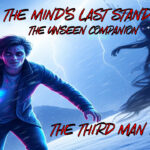
What Exactly Is the “Third Man”?
Imagine yourself in the most terrifying situation possible—perhaps you’re lost and injured in a vast, empty wilderness, or clinging to a piece of wreckage in a stormy ocean, completely alone and convinced that your time is running out. Suddenly, in that moment of ultimate despair and isolation, you get an incredibly strong, undeniable feeling that someone else is right there with you. You can’t physically see them, touch them, or hear their footsteps, but the sense of their presence is so real and vivid that it almost feels tangible. This profound and mysterious phenomenon is what people commonly refer to as the “Third Man Syndrome” or the “Third Man Factor.”
This isn’t just a fleeting thought or a hopeful wish; it’s a deep, pervasive awareness of an additional entity accompanying you. While its form is unseen, its nature is almost universally described as benevolent, supportive, and comforting. It’s not a scary or threatening presence; quite the opposite. This invisible companion seems to appear specifically to offer solace and reassurance, calming your racing heart and cutting through the overwhelming fear and despair. It feels like a silent guardian, or a compassionate ally has materialized out of nowhere, alleviating the crushing burden of being utterly alone in a desperate fight for survival.
The experience is often so powerful that survivors describe it as a profound shift in their perception of reality. The crushing weight of isolation suddenly lifts, replaced by an inexplicable sense of companionship. This isn’t just a psychological trick that makes you feel less alone; it genuinely feels like a distinct, sentient entity has joined your ordeal. The reality of this unseen presence is so convincing for those who experience it that they often emerge from their ordeal with an unwavering conviction that they were truly helped by something beyond ordinary understanding.
The “Third Man” seems to appear precisely when an individual is pushed to their absolute limits—physically, mentally, and emotionally. It’s when the body is exhausted, the mind is reeling from stress, and the spirit is on the verge of breaking that this phenomenon tends to manifest. It acts as a lifeline, providing a psychological anchor in the storm, preventing the individual from succumbing to the overwhelming sense of hopelessness that often accompanies extreme survival situations.
So, at its core, the “Third Man” is a unique and often life-saving experience where a person under unimaginable duress senses the presence of an unseen, benevolent companion. This presence feels incredibly real, provides immense comfort, and fundamentally alters the survivor’s mental state, helping them to persevere through situations that would otherwise seem impossible to overcome alone. It’s a mysterious testament to the mind’s ability to find extraordinary ways to survive.
What Does This Invisible Helper Do?
The “third man” is far more than just a passive presence; it actively intervenes to help the individual survive their ordeal, providing crucial psychological and sometimes even seemingly physical aid. Its role is deeply supportive and guiding, directly counteracting the debilitating effects of fear, despair, and isolation that typically accompany life-threatening situations. The assistance offered by this unseen companion is always benevolent and seems tailored to the immediate needs of the person in distress, acting as a crucial resource when all other help is beyond reach.
One of its primary functions is to provide profound emotional support and calm. When facing extreme danger and exhaustion, individuals are often overwhelmed by panic, anxiety, and a crushing sense of loneliness. The “third man” brings an inexplicable sense of peace and reassurance, settling the racing mind and replacing terror with a surprising clarity of thought. This calming influence allows the survivor to maintain composure and think more rationally, making better decisions under pressure than their desperate circumstances would otherwise permit. It transforms a chaotic, terrifying struggle into a more focused, manageable challenge.
Beyond emotional comfort, the “third man” frequently offers direct guidance and practical advice. Survivors often report hearing a clear voice—whether it sounds like their own internal monologue but with uncanny authority, or a distinct, external voice—giving precise instructions. This guidance can range from simple words of encouragement like “keep moving” or “don’t give up,” to highly specific tactical advice such as which direction to take, how to conserve energy, or even warning of unseen dangers like crevasses or thin ice. These perceived directives are often credited with saving lives, making the “third man” a vital source of practical wisdom in dire moments.
this unseen presence often instills an extraordinary surge of determination and renewed willpower. When the body is utterly exhausted and the spirit is on the verge of breaking, the “third man” provides the emotional fuel necessary to push beyond perceived limits. It’s like having an invisible coach or cheerleader who relentlessly urges you onward, instilling a fierce resolve to survive. This renewed sense of purpose is not just a fleeting emotion but a sustained drive that enables individuals to endure physical pain and mental anguish far beyond what they believed themselves capable of, preventing them from succumbing to despair.
in some remarkable accounts, survivors even perceive physical assistance, despite no one being visibly present. This can manifest as a feeling of a gentle push on the back when climbing, a guiding hand on the shoulder, or a sensation of someone helping to share a physical burden. While these sensations are likely products of the mind under extreme stress, they feel incredibly real to the individual and further reinforce the active, benevolent role of the “third man.” This perceived physical aid, combined with the emotional and cognitive guidance, creates a holistic support system that empowers the individual to persevere through the most insurmountable challenges.
When Does It Happen?
The phenomenon of the “Third Man” is almost exclusively triggered by situations of profound, life-threatening stress and extreme duress, pushing individuals to the absolute brink of human endurance. These are not everyday challenges but scenarios where survival is genuinely uncertain, and the stakes are literally life or death. The environment and circumstances play a crucial role in creating the conditions for this unique psychological response to emerge.
Common contexts where the “Third Man” appears involve extreme isolation and exposure to hostile environments. Think of solo adventurers on vast, desolate polar expeditions, mountaineers stranded on treacherous high-altitude peaks, or sailors adrift in the immense and unforgiving open ocean after a shipwreck. In these situations, the body is subjected to intense physiological stressors such as severe cold, dehydration, starvation, sleep deprivation, and extreme fatigue. The brain, under such immense pressure, begins to function in altered states, setting the stage for the phenomenon.
Beyond physical hardship, the overwhelming psychological burden of these situations is a key factor. The fear of death, the crushing loneliness of being utterly cut off from human contact, and the profound sense of helplessness can be as debilitating as any physical threat. When an individual realizes that all conventional help is impossible, and they are truly on their own, the mind seems to activate deep-seated survival mechanisms, of which the “Third Man” is a prominent example.
The prolonged nature of the stress also seems to be a significant contributor. It’s not typically a sudden, fleeting moment of panic, but rather an extended period of sustained physical and mental anguish. This continuous pressure can lead to a breakdown of normal cognitive processes, blurring the lines between reality and perception. It’s within this prolonged state of altered consciousness, brought on by extreme physiological and psychological strain, that the “third man” often appears to offer its unique form of aid and comfort, providing the necessary fortitude to endure the unending hardship.
Therefore, understanding the “Third Man Syndrome” necessitates recognizing the extreme crucible in which it manifests. It is a powerful demonstration of the human mind’s astonishing capacity for resilience and adaptation when confronted with the ultimate challenge of survival. The phenomenon suggests that under specific conditions of profound stress, the human psyche possesses an inherent ability to generate supportive, externalized presences, acting as a crucial internal resource to navigate and overcome the most perilous of situations, ultimately increasing the chances of survival against overwhelming odds.
Famous Examples
1. Ernest Shackleton’s Antarctic Expedition (1916)
Context: Following the crushing of their ship Endurance by pack ice in 1915, Ernest Shackleton and two companions—Tom Crean and Frank Worsley—embarked on a desperate 36-hour march across the uncharted glaciers and mountains of South Georgia Island. Exhausted, frostbitten, and facing hypothermia, they carried only rudimentary equipment: a rope, an adze, and screws from their lifeboat driven through their boots for traction.
The Encounter: Throughout the trek, all three men independently sensed a “divine companion” guiding them. Shackleton described it as an incorporeal fourth presence, writing, “It seemed to me often that we were four, not three.” Worsley later confirmed, “I had the subconscious feeling that there were four of us,” while Crean privately admitted the same to friends. None spoke of it during the ordeal, fearing it signaled delirium. The presence provided directional intuition—steering them away from crevasses—and emotional fortitude amid blizzards.
Interpretations: Shackleton framed it as divine Providence, while skeptics like biographer Roland Huntford attributed it to dehydration-induced hallucinations. Modern neurologists suggest extreme stress triggered temporal-parietal junction (TPJ) dysfunction, manifesting a “felt presence”.
Impact: The trio reached Stromness whaling station, enabling the rescue of all 22 crewmen left on Elephant Island. Shackleton’s account in South (1919) popularized the phenomenon, inspiring T.S. Eliot’s The Waste Land (1922), which coined the term “third man”.
2. Ron DiFrancesco (9/11 World Trade Center Survivor)
Context: On September 11, 2001, DiFrancesco was on the 84th floor of the South Tower when United Flight 175 struck. Trapped in smoke and debris, he attempted to descend but collapsed near the 81st floor, overcome by toxic fumes and despair.
The Encounter: A commanding male voice—distinct from human rescuers—shouted, “Get up!” and called him by name. DiFrancesco felt an invisible hand physically lift him and steer him toward a stairwell. “I was led to the stairs… I was definitely led,” he recounted. The presence radiated calm, countering his panic with reassurance: “You can do this.” He was the last person to escape above the impact zone before the tower collapsed.
Interpretations: DiFrancesco insisted it was an angel. Scientists propose auditory hallucinations from temporal lobe activation under duress. John Geiger notes such experiences often involve tactile sensations, blurring neurological and spiritual explanations.
Impact: DiFrancesco survived with burns and lung damage. His testimony became pivotal in Geiger’s The Third Man Factor, illustrating the syndrome’s role in modern disasters.
3. Joe Simpson (Andes Mountaineer, 1985)
Context: During a descent of Peru’s Siula Grande, Simpson shattered his leg in a fall, was lowered into a crevasse by his partner Simon Yates, and presumed dead. Stranded without food or water, he faced a five-day crawl across glaciers to base camp.
The Encounter: An authoritative voice countered his despair with directives like “Don’t stop now!” and “Go left!” It navigated him through ice fields and crevasses, once urging him to sip putrid water to avoid dehydration. Simpson described it as an external intelligence overriding his logical mind: “It wasn’t my voice—it was impatient, almost scornful”.
Interpretations: Simpson rejected supernatural claims, aligning with psychologist Julian Jaynes’ “bicameral mind” theory: stress splits consciousness into a “speaker” (right brain) and “listener” (left brain). Hypoxia and pain likely exacerbated this.
Impact: His survival, documented in Touching the Void (1988), underscores the syndrome’s life-saving role in solo ordeals.
4. Frank Smythe (Mount Everest Summit Attempt, 1933)
Context: After his team turned back due to storms and oxygen deprivation at 27,000 feet, Smythe continued solo toward Everest’s summit—a near-suicidal effort in 1933 climbing conditions.
The Encounter: Smythe sensed an unseen companion so vividly that he offered it Kendal mint cake. “I had the strong feeling that I was accompanied by a second person,” he wrote. The presence alleviated isolation and provided psychological resilience, though it vanished when he turned to look. At 28,000 feet—just 1,000 feet short of the summit—he accepted defeat but credited the presence for his mental endurance.
Interpretations: Scientists attribute this to hypoxia and sensory deprivation in “whiteout” conditions. Smythe later mused it might be the spirit of a deceased climber, reflecting mountaineering lore’s blend of science and mysticism.
Impact: His diary entry became a foundational account in exploration psychology, cited in studies on high-altitude hallucinations.
5. James Sevigny (Avalanche Survivor, Canadian Rockies)
Context: In 1982, Sevigny and climbing partner Richard Whitmire were buried under an avalanche near Lake Louise, Alberta. Whitmire died instantly; Sevigny awoke with a broken back, internal bleeding, and torn ligaments.
The Encounter: As Sevigny prepared to die, a physical presence manifested behind his right shoulder. It mentally urged, “You can’t give up,” and dispensed survival advice: “Follow the blood dripping from your nose like an arrow.” The presence guided his six-hour crawl, its proximity palpable during agonizing moments. Upon reaching base camp, Sevigny felt profound loneliness when it vanished.
Interpretations: Sevigny viewed it as a transcendent guardian. Neurologist Olaf Blanke’s experiments link such “felt presences” to TPJ disruptions during trauma—a hardwired coping mechanism.
Impact: Rescuers airlifted him to safety; he recovered after months of rehabilitation. His case exemplifies the syndrome’s role in trauma-induced paralysis reversal.
6. Reinhold Messner (Nanga Parbat Expedition, 1970)
Context: After summiting Nanga Parbat with his brother Günther, Reinhold faced a catastrophic descent. Günther, debilitated by altitude sickness, vanished in an icefall. Exhausted and grieving, Messner navigated alone through a blizzard.
The Encounter: Messner sensed a “third climber” descending beside him, “just out of my field of vision.” Though invisible, its proximity felt tangible—”I could sense his presence; I needed no proof.” It provided navigational certainty through whiteout conditions, reducing his panic.
Interpretations: Messner, a skeptic, rejected supernatural theories, calling it a natural brain response to “invent survival” when reality offers none. Geiger links this to evolutionary psychology: the mind conjures companionship to prevent fatal resignation.
Impact: Messner’s survival cemented his climbing legacy. His account expanded the syndrome’s documentation beyond polar explorers.
7. Aron Ralston (Canyoneering Accident, 2003)
Context: Ralston was pinned by an 800-pound boulder in Utah’s Bluejohn Canyon. After six days of dehydration, hypothermia, and failed escape attempts, he recorded farewell messages for his family.
The Encounter: Hallucinating, Ralston saw a vision of himself playing with a future son—a boy missing his right arm. This epiphany ignited his resolve to amputate his crushed forearm with a dull multi-tool. “It was the best idea I will ever have,” he said, describing euphoria, not horror. The vision’s timing proved critical: rescuers found him just 30 minutes before blood loss would have killed him.
Interpretations: Psychologists frame this as a stress-induced dissociative state, where the brain projects future selves to override immediate suffering. Ralston viewed it as spiritual intervention.
Impact: His survival inspired the film 127 Hours. The case broadened Third Man Syndrome to include premonitory visions, not just auditory or tactile presences.
8. Vincent Lam (Medical School Stress, 1990s)
Context: Unlike physical ordeals, Lam’s crisis was psychological: overwhelmed while studying for medical entrance exams, he collapsed during a panic attack, doubting his career path .
The Encounter: A “guardian angel” appeared—visually indistinct but radiating calm—and advised, “Your purpose is healing, not perfection.” It anchored him during dissociation, guiding his focus back to study materials. The presence faded once his breathing steadied.
Interpretations: Lam, a physician, acknowledged stress-triggered dissociation but also embraced spiritual symbolism. Therapists now use “cultivated inner characters” to help patients self-soothe, validating such experiences as cognitive resources.
Impact: Lam regained clarity, entered medical school, and later won literary awards. His case illustrates the syndrome’s adaptability to non-physical crises.
Patterns and Insights from Geiger’s Research
Triggers: Extreme stress (e.g., isolation, imminent death) consistently precedes the phenomenon. Mountaineers (32%) and disaster survivors (29%) report the highest incidence.
Manifestations: 45% auditory (voices), 30% tactile (physical guidance), 25% visual (figures). The presence often delivers actionable advice, distinguishing it from chaotic hallucinations.
Scientific Framework: Neurologist Olaf Blanke induced “felt presences” by disrupting TPJ activity with robotics, confirming the brain can generate externalized self-images under sensory deprivation.
Cultural Universality: Similar phenomena appear globally—Arctic explorers’ “shadow companions,” Himalayan “mountain deities”—suggesting a cross-cultural survival instinct.
“Whether neurons or angels, the Third Man reveals a profound truth: humans are hardwired to hope when reality offers none.”
—John Geiger, The Third Man Factor
In modern times, the “Third Man” continues to be reported by contemporary adventurers, athletes, and military personnel, confirming that it’s not just a relic of the past. Figures like legendary mountaineer Reinhold Messner have openly spoken about feeling an unseen presence during his solo and near-fatal descent from Nanga Parbat, providing comfort and motivation in his extreme grief and exhaustion. These ongoing accounts reinforce the reality and universality of the “Third Man Syndrome” as a profound and often life-saving aspect of human experience in the face of unimaginable adversity.
Why Does It Happen? (Theories)
Mind’s Survival Trick (Psychological Coping Mechanism)
One of the most widely accepted and scientifically explored explanations for the “Third Man” phenomenon is that it acts as a powerful psychological coping mechanism, an incredible testament to the mind’s capacity for self-preservation in extreme situations. When individuals are pushed to the absolute limits of human endurance—facing overwhelming threats, profound isolation, and severe physiological deprivation—the human psyche activates deep-seated defense strategies to maintain its integrity and facilitate survival. The creation of an external, benevolent presence is theorized to be one such ingenious mechanism.
In dire circumstances, the mind is under immense strain. Factors like severe sleep deprivation, dehydration, starvation, extreme cold, or lack of oxygen can significantly impair cognitive functions, leading to confusion and disorientation. The “third man” appears to counter these debilitating effects by providing a psychological anchor, alleviating the crushing burden of loneliness and despair. It’s as if the brain, in its desperate attempt to keep the individual going, projects its own adaptive capabilities outward, making an internal struggle feel like a shared journey with a supportive companion.
This coping mechanism serves several vital functions that are directly linked to survival. Firstly, it dramatically reduces the psychological impact of isolation and loneliness, which can be as deadly as physical ailments. The perception of a benevolent companion provides immense comfort and emotional support, preventing the individual from succumbing to despair and giving up the fight. It satisfies a fundamental human need for connection, even if the connection is a product of their own mind.
Secondly, the “third man” helps regulate overwhelming emotions, particularly extreme fear and anxiety. The calm and reassuring presence acts as a mental buffer, allowing the survivor to maintain a clearer head and make more rational, life-saving decisions. Instead of being paralyzed by panic, they can focus on the immediate tasks required for survival. This ability to maintain mental composure under dire circumstances is critical for navigating complex and dangerous situations.
this “survival trick” often acts as an externalized source of guidance and motivation. When logical thought is impaired by exhaustion, the perceived instructions or encouragement from the unseen entity can provide concrete direction and a renewed sense of purpose. It allows the individual to tap into deep reserves of strength and resilience that might otherwise remain dormant. Essentially, the mind projects its own adaptive solutions and motivational imperatives onto an external figure, making them easier to accept and act upon during moments of extreme vulnerability, ultimately increasing the chances of survival.
Brain’s Overload (Hallucination/Sensory Illusion)
Another prominent theory suggests that the “Third Man” phenomenon can be explained as a form of hallucination or sensory illusion, directly resulting from the extreme physiological and psychological stressors inherent in survival situations. The conditions that typically precede the “third man” experience—such as prolonged sleep deprivation, extreme cold, dehydration, starvation, and oxygen deprivation—are well-documented triggers for altered states of consciousness, including vivid perceptual distortions. The brain, under such immense pressure, can misinterpret sensory input or even generate new sensations internally.
In environments like vast, monotonous oceans or isolated snowy landscapes, sensory deprivation can also play a significant role. The lack of varied external stimuli can cause the brain to generate its own internal experiences to fill the void, sometimes manifesting as auditory or visual hallucinations. When the body is pushed to its limits, for instance due to hypothermia or severe dehydration, the brain may enter states similar to dreaming or sleep, where the boundaries between reality and perception become blurred, making it more prone to creating vivid illusions.
a key point of discussion and one of the most intriguing aspects of this theory is the remarkably consistent benevolent and helpful nature of these perceived hallucinations. While typical stress-induced hallucinations can often be frightening, the “third man” is almost universally described as a comforting, guiding entity. This consistency suggests that if it is a hallucination, it is a highly adaptive one, purpose-built by the mind to aid survival rather than hinder it. It differentiates the “Third Man” from other forms of stress-induced psychosis, which are often disorganized and counterproductive.
the “shared” aspect of the experience in famous accounts like Shackleton’s adds a layer of complexity to the simple hallucination theory. If multiple individuals independently perceive the same “third man,” it challenges the notion of a purely individual, random hallucination. While it’s possible that similar physiological states could induce similar adaptive hallucinations in multiple people, it nonetheless suggests a more complex neurological or psychological phenomenon at play than a simple, isolated delusion. The brain’s ability to create such a specific, supportive hallucination under duress remains a profound area of inquiry.
while the hallucination/sensory illusion theory offers a plausible physiological basis for the “third man” phenomenon, it often needs to be complemented by a psychological framework that explains why the hallucinations take such a consistently benevolent and adaptive form. It highlights the intricate interplay between physiological stress, brain function, and the mind’s powerful capacity to generate internal experiences that directly contribute to the continuation of life in the face of overwhelming odds. The brain’s ability to create such a purposeful “illusion” is a testament to its extraordinary survival programming.
Deep-Seated Instinct (Bicameral Mentality/Ancestral Whispers)
A more speculative, but deeply fascinating, theory attempting to explain the “Third Man” delves into our evolutionary past, suggesting it could be a manifestation of “ancestral whispers” or an innate, deeply embedded survival program encoded within our DNA. This theory posits that humanity, having faced countless life-threatening challenges throughout its evolutionary journey, may have developed a hardwired mechanism to access collective ancestral wisdom or a fundamental survival resource when confronted with existential threats, externalizing it as a guiding presence.
This perspective is sometimes loosely connected to Julian Jaynes’s controversial idea of the “bicameral mentality,” which proposed that ancient humans lacked subjective consciousness and instead perceived directives from one part of their brain as external “voices of gods.” While Jaynes’s theory is heavily debated, its application here suggests that in extreme, life-threatening situations, under immense stress and sensory deprivation, the modern human mind might regress to a more archaic state. In this state, the brain’s own internal problem-solving, intuitive insights, or even adaptive self-talk might be perceived as external commands or the presence of a distinct entity, much like the “commands of the gods” in Jaynes’s model.
From this viewpoint, the “third man” is not an external spiritual entity or a random hallucination, but rather the survivor’s own unconscious mind communicating vital information or providing crucial motivation in a way that is perceived as external. For example, a deeply embedded survival instinct—like an innate sense of direction or an intuitive understanding of the environment—might be “voiced” by a part of the brain and interpreted by the conscious mind as coming from an external, benevolent source. This externalization makes the guidance feel more authoritative and compelling, especially when the individual’s conscious will is weakened by exhaustion and fear.
This theory offers a compelling, if complex, neurological and evolutionary perspective on why the “third man” is so consistently supportive and guiding. If it is indeed the mind’s own deeper, more primal survival mechanisms communicating with the conscious self, then its benevolent nature makes perfect sense. The purpose of such a communication would be to facilitate survival, providing precisely the type of comfort, clear direction, and motivation that is reported by survivors. It essentially posits that the brain is hardwired to help itself, and in extreme circumstances, it might do so by creating an externalized projection of its own wisdom and willpower.
While highly speculative and lacking direct empirical evidence, the “ancestral whispers” or modified “bicameral” theory offers an intriguing framework for understanding the profound and often inexplicable effectiveness of the “third man” in life-threatening situations. It suggests that our capacity for survival is not just learned but deeply inherited, and that under extreme duress, the human mind can tap into this ancient wellspring of resilience, manifesting it as a benevolent, guiding presence that helps us navigate the most perilous of journeys, connecting us to the unbroken chain of life that extends back through time.
Spiritual Beliefs (Spiritual/Supernatural Interpretations)
For many individuals who experience the “Third Man Syndrome,” and for those who hear their compelling accounts, the most immediate and profound explanation is often spiritual or supernatural. Given the highly improbable nature of survival in many of these scenarios, coupled with the benevolent, guiding, and often life-saving nature of the perceived presence, it is deeply understandable that survivors might attribute their experience to divine intervention, the presence of guardian angels, or the spiritual guidance of deceased loved ones. This interpretation resonates deeply with individuals who already hold spiritual or religious beliefs, providing a powerful affirmation of their faith.
From a spiritual perspective, the “third man” is seen as a tangible manifestation of a higher power or spiritual helper, sent specifically to aid the individual in their moment of greatest need. The overwhelming feeling of comfort, the precise guidance, and the inexplicable strength often reported by survivors are viewed as direct evidence of a non-physical entity intervening directly in their worldly ordeal. For a person of faith, this explanation offers a profound sense of purpose and reinforces the idea that they are never truly alone, even when physically isolated, and that a divine plan or a protective force is actively at work in their lives.
This interpretation often gains significant strength from the profound emotional and psychological impact of the experience. Survivors frequently describe feeling an immense sense of gratitude, awe, and a deepened spiritual connection after their ordeal. The “third man” becomes more than a mere coping mechanism; it is a transformative encounter that reshapes their worldview and reinforces their belief in a realm beyond the purely physical. For many, the experience is so vivid, so real, and so impactful that it cannot be dismissed as mere hallucination or psychological trickery, leading them to embrace a supernatural explanation as the most fitting and meaningful.
the consistency of the benevolent nature of the “third man” across diverse accounts, regardless of the survivor’s background or specific religious beliefs, can be seen by some as evidence of a universal spiritual truth. While the perceived identity of the entity might vary (e.g., an angel, a spirit guide, a deity, or simply a “presence”), the core message of support, hope, and guidance remains constant, suggesting a common source of divine assistance in times of extreme human vulnerability. This shared experience across cultures and individual belief systems further strengthens the spiritual interpretation for its proponents, highlighting a universal connection to a higher power.
while scientific theories offer psychological and physiological explanations for the “Third Man Syndrome,” the spiritual or supernatural interpretation remains a deeply personal and compelling one for many. It addresses the profound mystery of the phenomenon by attributing it to forces beyond the material world, providing solace, meaning, and a sense of divine intervention in the face of unimaginable adversity. For those who believe, the “third man” is a powerful reminder that even in the darkest hours, help can come from unexpected, and sometimes miraculous, sources, leaving an indelible mark on their lives.

 5 True Ghost Stories of Knoxville Tennessee
5 True Ghost Stories of Knoxville Tennessee  The Minds Last Stand: The Third Man Factor
The Minds Last Stand: The Third Man Factor  Shadow Figures: They’ve Been Watching You All along
Shadow Figures: They’ve Been Watching You All along  The Bigfoot Mystery of Mt Saint Helens
The Bigfoot Mystery of Mt Saint Helens  Bigfoot’s Hidden Rage: Why some Encounters turn Deadly
Bigfoot’s Hidden Rage: Why some Encounters turn Deadly  Cheating Death at the Quantum Level
Cheating Death at the Quantum Level  Into the Unknown: Exploring the Michigan Triangle
Into the Unknown: Exploring the Michigan Triangle  The Shag Harbour UFO Incident
The Shag Harbour UFO Incident